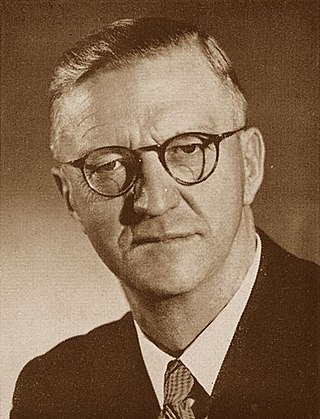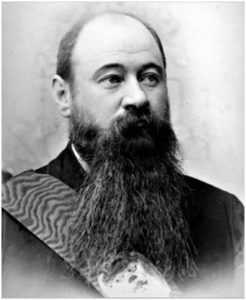
Bloemfontein, also known as Bloem, is the capital and the largest city of the Free State province in South Africa. It is often, and has been traditionally, referred to as the country's "judicial capital", alongside the legislative capital Cape Town and administrative capital Pretoria, although the highest court in South Africa, the Constitutional Court, has been in Johannesburg since 1994.

The Orange River Colony was the British colony created after Britain first occupied (1900) and then annexed (1902) the independent Orange Free State in the Second Boer War. The colony ceased to exist in 1910, when it was absorbed into the Union of South Africa as the Orange Free State Province.

Charles Robberts Swart, nicknamed "Blackie", was a South African politician who served as the last governor-general of the Union of South Africa from 1959 to 1961 and the first state president of the Republic of South Africa from 1961 to 1967.

MartinusTheunis Steyn was a South African lawyer, politician, and statesman. He was the sixth and last president of the independent Orange Free State from 1896 to 1902.

Petrus Steyn, is a small farming town between Tweeling and Kroonstad, 35 km north-east of Lindley in the Free State province of South Africa. It is at the centre of an agricultural area known for wheat, maize, sunflower, potato, cattle, hunting, sheep production and forms part of the breadbasket in the Free State. It is the highest town above sea level in the Free State. In 2012 the town's name was changed to Mamafubedu. Farming industries in Mamafubedu provide potatoes worldwide.
Brandfort, officially renamed Winnie Mandela in 2021, is a small agricultural town in the central Free State province of South Africa, about 60 km northeast of Bloemfontein on the R30 road. The town serves the surrounding farms for supplies and amenities. It is well known for once being home to the anti-apartheid stalwart and wife of Nelson Mandela, Winnie Mandela, during her banishment.

Winburg is a small mixed farming town in the Free State province of South Africa.

Heilbron is a small farming town in the Free State province of South Africa which services the cattle, dairy, sorghum, sunflower and maize industries. Raw stock beneficiation occurs in leisure foods, dairy products and stock feeds. It also serves as a dormitory town for the Gauteng metropolis.

Christiaan Rudolf de Wet was a Boer general, rebel leader and politician.

Francis William Reitz, Jr. was a South African lawyer, politician, statesman, publicist, and poet who was a member of parliament of the Cape Colony, Chief Justice and fifth State President of the Orange Free State, State Secretary of the South African Republic at the time of the Second Boer War, and the first president of the Senate of the Union of South Africa.

The University of the Free State is a multi-campus public university in Bloemfontein, the capital of the Free State and the judicial capital of South Africa. It was first established as an institution of higher learning in 1904 as a tertiary section of Grey College. It was declared an independent Afrikaans-language university in 1950 and the name was changed to the University of the Orange Free State. The university has two satellite campuses. Initially a whites-only precinct, the university was fully de-segregated in 1996. The first black university vice-chancellor was appointed in 2010.
Jan Christiaan Smuts, OM was a prominent South African and Commonwealth statesman and military leader. He served as a Boer general during the Boer War, a British general during the First World War and was appointed field marshal during the Second World War. In addition to various cabinet appointments, he served as prime minister of the Union of South Africa from 1919 to 1924 and from 1939 to 1948. He played a leading part in the post war settlements at the end of both world wars, making significant contributions towards the creation of both the League of Nations and the United Nations.

Anton van Wouw was a Dutch-born South African sculptor regarded as the father of South African sculpture.

The National Women's Monument in Bloemfontein, South Africa, is a monument commemorating the roughly 27,000 Boer women and children who died in British concentration camps during the Second Boer War. The Monument is a Provincial Heritage Site in the Free State.
Sir John George Fraser was a prominent Orange Free State lawyer, politician, statesman and member of the Volksraad. He was knighted in 1905.
Norvalspont is a small town in Pixley ka Seme District Municipality in the Northern Cape province of South Africa. The name is Afrikaans for Norval’s ferry, and named after an enterprising Scot who constructed a ferry here in 1848. The settlement lies some 40 km east-north-east of Colesberg and 43 km west-north-west of Venterstad, on the southern bank of the Orange River, just below the Gariep Dam.

The Statue of Paul Kruger is a bronze sculpture located in Church Square in Pretoria, South Africa. The statue depicts Paul Kruger, the Boer political and military leader and President of the South African Republic from 1883 to 1900, and four unnamed Boer soldiers. The Statue of Paul Kruger was sculpted in 1896 and was installed in its current location in Church Square in 1954.

The Old Presidency or Ou Presidensie (Afrikaans) is a museum, art gallery and theatre in the city of Bloemfontein, South Africa, located on President Brand Street in the heart of the city. The former residence of the President of the Republic of the Orange Free State from 1886 until 1899 when the city fell to the British Empire during the Second Anglo-Boer War.
Onze Rus was the farm owned by President Martinus Theunis Steyn, the last State President of the Orange Free State. It is located around 22 km south of Bloemfontein, South Africa. After the Second Boer War, he tended to operate from here as a leader and adviser to the Afrikaner people.
The Port Elizabeth Concentration Camp was a British run concentration camp in Port Elizabeth, South Africa, at that time part of the Cape Colony, used as part of the Boer War. It was active from December 1900 to around November 1902. Originally sited on Port Elizabeth racecourse, it was moved to higher ground, two miles north-west of the town. It housed 200 children and 86 women behind a 1.5-m high fence, in zinc and iron huts. A separate, fenced camp housed 32 men nearby. Under John Fox Smith, the racetrack had been used earlier to house Uitlander refugees from Boer territory, but the growing Boer population led to relocating such internees to the location described here, a former Prince Alfred's Guard barracks.














